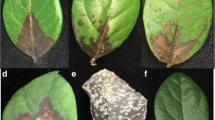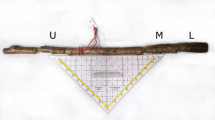Abstract
A range of plants was tested for their susceptibility to Drechslera avenacea (M.A. Curtis ex Cooke) Shoem., the possible active ingredient in a bioherbicide for use against the weed Avena fatua. Test plants were chosen on the basis of phylogenetic proximity to the weed, recorded susceptibility to closely related pathogens or physical proximity in agricultural systems to wheat, the crop in which the weed is to be controlled. The fungus caused mortality of A. fatua and Avena byzantina cv. Yarren. Sporulation occurred on A. fatua and, on one occasion (of three challenges), on Brassica napus cv. Oscar. Severe disease symptoms were recorded on 13 species of grass and mild infection on a further seven species. We observed a much broader host range than previously recorded. The reasons for, and implications of, this are discussed and the suitability of D. avenacea as a bioherbicide assessed.
Similar content being viewed by others
References
Auld BA, Medd RW (1992) ‘Weeds. An illustrated botanical guide to the weeds of Australia.’ (Inkata Press: Melbourne)
Daniel JT, Templeton GE, Smith RJ, Fox WT (1973) Biological control of Northern Jointvetch in rice with an endemic fungal disease. Weed Science 21, 303–307.
Deadman ML, Cooke BM (1989) An analysis of rain-mediated dispersal of Drechslera teres conidia in field plots of spring barley. Annals of Applied Biology 115, 209–214.
Hetherington SD, Auld BA, Smith HE (1998) A possible bioherbicide for Avena fatua L. (wild oats): isolate collection and host range testing. Proceedings of the Linnaean Society of New South Wales 119, 219–225.
Kastanias MA, Chrysayi-Tokousbalides M (2000) Herbicidal potential of pyrenophorol isolated from a Drechslera avenae pathotype. Pest Management Science 56, 227–232.
Sivanesan A (1987) ‘Graminicolous species of Bipolaris, Curvularia, Drechslera, Exserohilum and their teleomorphs.’ (CAB International: Wallingford)
TeBeest DO (1988) Additions to host range of Colletotrichum gloeosporioides f. sp. aeschynomene. Plant Disease 72, 16–18.
Wapshere AJ (1975) A protocol for biological control of weeds. PANS 21, 295–303.
Wapshere AJ (1990) Biological control options for some grass weeds in Australia. In ‘Proceedings of an international conference on alternatives to the chemical control of weeds’. pp. 80-84, Rotorua, New Zealand.
Weidemann GJ, Tebeest DO (1990) Biology of host range testing for biocontrol of weeds. Weed Technology 4, 465–470.
Weidemann GJ, TeBeest DO, Cartwright RD (1988) Host specificity of Colletotrichum gloeosporioides f. sp. aeschynoemene and C. truncatum in the Leguminosae. Phytopathology 78, 986–990.
Wilson S (1987) The scope for biological control of Avena fatua L. with Drechslera avenae (Eidam) Sharif. PhD Thesis, Oxford University, UK.
Zhang W, Watson AK (1997) Host range of Exserohilum monoceras, a potential bioherbicide for the control of Echinochloa species. Canadian Journal of Botany 75, 685–692.
Zonjian Z, Yanghan L (1996) Discovery, isolation and pathogenicity study of a wild oat (Avena fatua) biological control fungus. In ‘Proceedings 3rd international bioherbicide workshop’. p. 30. Stellenbosch, South Africa.
Author information
Authors and Affiliations
Corresponding author
Rights and permissions
About this article
Cite this article
Hetherington, S.D., Auld, B.A. Host range of Drechslera avenacea, a fungus with potential for use as a biological control agent of Avena fatua . Australasian Plant Pathology 30, 205–210 (2001). https://doi.org/10.1071/AP01020
Received:
Accepted:
Issue Date:
DOI: https://doi.org/10.1071/AP01020




